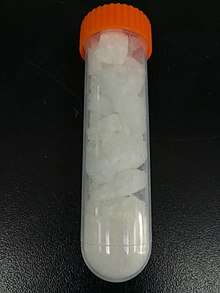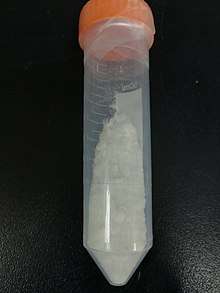Yttrium compounds
An yttrium compound is a chemical compound containing yttrium (element symbol: Y). Among these compounds, yttrium generally has a +3 valence. The solubility properties of yttrium compounds are similar to those of the lanthanides. For example oxalates and carbonates are hardly soluble in water, but soluble in excess oxalate or carbonate solutions as complexes are formed. Sulfates and double sulfates are generally soluble. They resemble the "yttrium group" of heavy lanathanide elements.
Chalcogenides
The oxides and hydroxides of yttrium are yttrium oxide (Y2O3) and yttrium hydroxide (Y(OH)3), respectively, and they are both white solids which are hardly soluble in water. Among them, yttrium oxide can be prepared by heating yttrium carbonate or yttrium oxalate. Alternatively the oxychloride, Y3O4Cl can be heated in air to yield the oxide.
Yttrium hydroxide can be precipitated by the reaction of soluble yttrium compounds with sodium hydroxide or ammonia, and can also be obtained by the hydrolysis of yttrium alkoxide. Hydroxy acids and sugars present in the solution will prevent the formation of precipitates due to the formation of stable coordination compounds. Yttrium hydroxide can be decomposed by heating. Firstly, basic yttrium oxide (YO(OH)) is formed, and when heating is continued yttrium oxide is obtained. Both yttrium oxide and yttrium hydroxide are easily soluble in strong acids to form corresponding yttrium salts.
Yttrium chalcogenides Y2S3, Y2Se3, and Y2Te3 are known. They can be obtained by the direct combination of elementary substances or anhydrous chlorine. The reaction of compounds with chalcogenide gives: [9]
- Y2O3 + 3 H2E → Y2E3 + 3 H2O
- 2 Y + 3 E → Y2E3 (E = S, Se, Te)
Halides
Yttrium halides can be obtained by reacting yttrium oxide, yttrium hydroxide or yttrium carbonate with the corresponding hydrohalic acid solution. For yttrium chloride (YCl3) and yttrium bromide (YBr3), the yttrium halide hydrate can be precipitated by cooling their saturated solution or by passing in the corresponding hydrogen halide. Yttrium halides, like lanthanide metal halides, cannot be obtained by direct heating of the hydrate, otherwise yttrium oxyhalide (YOX) will be formed. Anhydous compounds can be obtained by heating the hydrate in a hydrogen halide stream, or by treating it with ammonium halide and sulfoxide. [10] In addition to forming hydrates (YF3 · 1 / 2H2O, YCl3 · 6H2O, YBr3·6H2O, and YI3·8H2O), yttrium halides can also form complexes with some ligands. Substances, such as [Y (Me 3 PO) 6 ] X 3 or [Y (Me 3 AsO) 6 ] X 3 (X = Cl, Br, I) and the like with phosphine oxides. [11] Yttrium and halogens (except fluorine [12] ) or pseudohalogens can also form complexes, such as Cs 3 [Y2I9 ], (Bu4N)3 [Y(NCS)6 ], etc.[1]
The reaction of yttrium metal with yttrium chloride or yttrium bromide yields low-oxidation monohalides YX and yttrium sesquichloride Y2Cl3, and sesquibromide Y2Br3 (X = Cl, Br).[2]
Binary compounds

Two yttrium hydrides are known at standard conditions, YH2 and YH3.[3] Under high pressures, YH9, a polyhydride is stable under pressure, and is a superconductor at temperatures up to 243K.[4][5]
Yttrium and pnictides can form compounds with the chemical formula YE (E = N, P, As, Sb). They can be hydrolyzed in humid air and emit volatile hydrides EH3.
Yttrium and carbon can form a variety of compounds, such as Y2C3,[6] YC2.[7] They can be made in several ways:
- 2 Y + 3 C → Y2C3
- Y2O3 + 7 C → 2 YC2 + 3 CO ↑
There are also several yttrium silicides, such as YSi2,[8] Y5Si4 and YSi.[9]
Yttrium and boron can also form many colourful compounds, such as gold YB4 , blue YB6 , light blue YB12. They are metallic; YB66 is a semiconductor, and the resistivity at room temperature is 106 Ω·cm.[10]
Oxoacid salts

Most of the salts from strong acids are soluble in water. The ionic radius (0.900) of yttrium in [Y(H2O)6]3+ is similar to that of holmium [Ho(H2O)6]3+ (0.901), and differs from easily hydrolyzed [Sc(H2O)6]3+.[11]
Yttrium carbonate and yttrium oxalate are sparingly soluble in water, but are dissolved in acid. They decompose on heating to yttrium oxide.
Organic acid salts

Organic acid salts of yttrium include yttrium formate, yttrium acetate, yttrium propionate, yttrium butyrate. They are all made by dissolving the carbonate or oxide in the corresponding acid. Aromatic polycarboxylates like phthalic acid or trimellitic acid have a rigid shape, and can coordinate more than one yttrium atom to form a metal-organic framework compound.[12][13]
References
- Ilyukhin, A. B.; Petrosyants, S. P. (5 December 2012). "Structural diversity of yttrium(III) halide complexes". Russian Journal of Inorganic Chemistry. 57 (13): 1653–1681. doi:10.1134/S0036023612130037.
- Mattausch, H.; Hendricks, J. B.; Eger, R.; Corbett, J. D.; Simon, A. (July 1980). "Reduced halides of yttrium with strong metal-metal bonding: yttrium monochloride, monobromide, sesquichloride, and sesquibromide". Inorganic Chemistry. 19 (7): 2128–2132. doi:10.1021/ic50209a057.
- Kume, Tetsuji; Ohura, Hiroyuki; Takeichi, Tomoo; Ohmura, Ayako; Machida, Akihiko; Watanuki, Tetsu; Aoki, Katsutoshi; Sasaki, Shigeo; Shimizu, Hiroyasu; Takemura, Kenichi (31 August 2011). "High-pressure study of ScH3 : Raman, infrared, and visible absorption spectroscopy". Physical Review B. 84 (6): 064132. Bibcode:2011PhRvB..84f4132K. doi:10.1103/PhysRevB.84.064132.
- Peng, Feng; Sun, Ying; Pickard, Chris J.; Needs, Richard J.; Wu, Qiang; Ma, Yanming (8 September 2017). "Hydrogen Clathrate Structures in Rare Earth Hydrides at High Pressures: Possible Route to Room-Temperature Superconductivity". Physical Review Letters. 119 (10): 107001. Bibcode:2017PhRvL.119j7001P. doi:10.1103/PhysRevLett.119.107001.
- Kong, P. P.; Minkov, V. S.; Kuzovnikov, M. A.; Besedin, S. P.; Drozdov, A. P.; Mozaffari, S.; Balicas, L.; Balakirev, F. F.; Prakapenka, V. B.; Greenberg, E.; Knyazev, D. A.; Eremets, M. I. (2019). "Superconductivity up to 243 K in yttrium hydrides under high pressure". arXiv:1909.10482. Bibcode:2019arXiv190910482K. Cite journal requires
|journal=(help) - Krupka, M.C.; Giorgi, A.L.; Krikorian, N.H.; Szklarz, E.G. (January 1969). "High pressure synthesis and superconducting properties of yttrium sesquicarbide". Journal of the Less Common Metals. 17 (1): 91–98. doi:10.1016/0022-5088(69)90039-3.
- Zhou, Dan; Seraphin, Supapan; Wang, Su (19 September 1994). "Single‐walled carbon nanotubes growing radially from YC2 particles". Applied Physics Letters. 65 (12): 1593–1595. Bibcode:1994ApPhL..65.1593Z. doi:10.1063/1.112924.
- Siegal, Michael P.; Kaatz, Forrest H.; Graham, William R.; Santiago, Jorge J.; Van der Spiegel, Jan (October 1989). "Formation of epitaxial yttrium silicide on (111) silicon". Journal of Applied Physics. 66 (7): 2999–3006. Bibcode:1989JAP....66.2999S. doi:10.1063/1.344184.
- Button, T.W.; McColm, I.J.; Ward, J.M. (April 1990). "Preparation of yttrium silicides and oxide-silicides". Journal of the Less Common Metals. 159: 205–222. doi:10.1016/0022-5088(90)90149-E.
- Oliver, D.W.; Brower, George D. (December 1971). "Growth of single crystal YB66 from the melt". Journal of Crystal Growth. 11 (3): 185–190. Bibcode:1971JCrGr..11..185O. doi:10.1016/0022-0248(71)90083-2.
- Biochemistry of scandium and yttrium. Part 1, Physical and chemical fundamentals. Springer US. ISBN 978-1-4613-6936-3.
- Thirumurugan, A.; Natarajan, Srinivasan (2004). "Synthesis, structure and luminescent properties of yttrium benzene dicarboxylates with one- and three-dimensional structure". Dalton Transactions (18): 2923. doi:10.1039/B408403A. PMID 15349168.
- Luo, Junhua; Xu, Hongwu; Liu, Yun; Zhao, Yusheng; Daemen, Luke L.; Brown, Craig; Timofeeva, Tatiana V.; Ma, Shengqian; Zhou, Hong-Cai (July 2008). "Hydrogen Adsorption in a Highly Stable Porous Rare-Earth Metal-Organic Framework: Sorption Properties and Neutron Diffraction Studies". Journal of the American Chemical Society. 130 (30): 9626–9627. doi:10.1021/ja801411f. PMID 18611006.
See also
- Category:Yttrium minerals